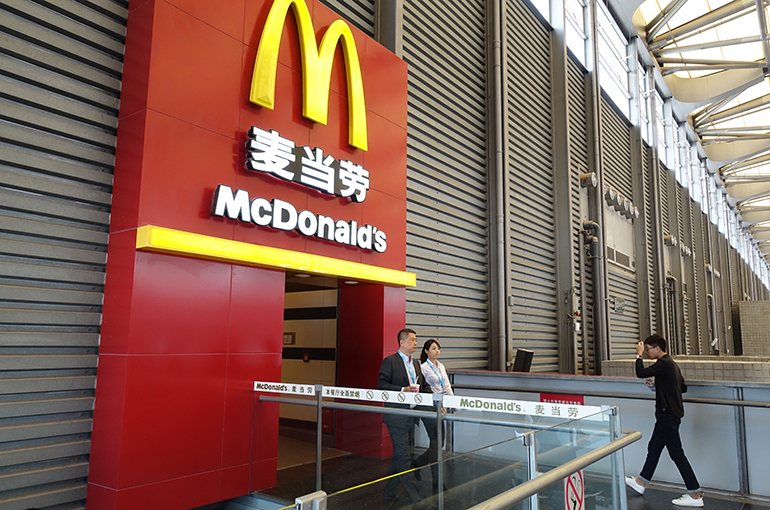 McDonald’s China Remains Upbeat on Chinese Market, CEO Says
McDonald’s China Remains Upbeat on Chinese Market, CEO Says(Yicai) Aug. 7 -- McDonald’s China will not change its ownership structure and the company will open more outlets in China, Chief Executive Officer Zhang Jiayin told Yicai in a recent interview.
It is now six years since Citic and Citic Capital Holdings along with US-based Carlyle Group jointly acquired an 80 percent stake in McDonald’s China, at which point the company name was changed to Jingongmen, which means golden arches in English.
Citic and Citic Capital hold a 52 percent stake, while Carlyle and McDonald’s Global hold 28 percent and 20 percent, respectively. “We will maintain the current shareholding structure,” said Zhang.
It is also 33 years since the fast-food company opened its first branch in the Chinese mainland.
China is a big growth market that cannot be ignored, said Zhang. In the United States, which has a population of just over 330 million, McDonald’s has opened 14,000 restaurants in the last 68 years. As China has a population of 1.4 billion, there is market space for McDonald’s to open more than 30,000, Zhang said.
McDonald’s had opened 2,500 outlets in the Chinese mainland before it renamed in 2017. The expansion has increased since then, and the number has now reached over 5,400.
“We opened half of the existing restaurants after the current ownership took over in 2017,” Zhang said, adding that the firm aims to open more than 900 new eateries in the mainland this year. The number will rise to 10,000 by 2028, she added.
The company’s single-store opening cost has dropped significantly from five years ago, Zhang noted. “The huge number of restaurants has a good scale effect in equipment purchase and store renovation, so the cost of opening a restaurant has declined.”
Targeting Smaller Cities
The company used to focus on first- and second-tier cities, but now about 50 percent of its restaurants are in third-, fourth-, and fifth-tier cities.
Zhang told Yicai that the lifestyles and consumption patterns in lower-tier cities are quite different from those in first-tier cities. “We customized the services according to the consumption characteristics of the people in small cities.”
But McDonald’s China still has a lot of room for development in the four traditional first-tier cities of Beijing, Shanghai, Guangzhou, and Shenzhen, Zhang said. For example, it has just over 400 restaurants in Beijing, which has a population of more than 20 million. By comparison, it has 800 in Australia, which has just over 25 million people.
The company currently uses the franchise business model only in western Yunnan province and three ethnic autonomous regions of Inner Mongolia, Tibet and Xinjiang, the company does not plan to expand the practice to other parts of the nation, said Zhang, regarding to whether the speed up in new store opening should open the door for more franchising.
Second-Half Optimism
McDonald’s China achieved strong results in the first half of the year, with a growth rate far ahead of that before Covid-19, Zhang said. This was mainly due to more new outlets and same store sales growth at existing restaurants.
Zhang said she was confident about growth in the second half, but also said this would depend on attitudes to spending, as consumers are now more cautious than ever. The relatively weak demand is a challenge for many retailers.
In response, McDonald’s will add creative new low-cost products and expand its sales channels. “We’ll not only develop our offline business but also make efforts in all online stores to revitalize offline and online sales channels.”
The new pricing should make consumers more confident about going to McDonald’s, Zhang said. “Promotions do have a short-term effect, but we prefer to make our customers feel there are great deals every day.”
New Products
As well as its efforts to expand in lower-tier cities, McDonald’s China has also introduced new products in recent years, such as an Angus Beef Burger, McCrispy Chicken, and a latte drink with more milk. The company says more than 90 percent of its food ingredients are locally sourced or produced in China.
The changes have been possible partly thanks to the localization of the decision-making group and the entire management team. “It has brought us closer to the changing market so that we can make decisions more quickly,” Zhang said.
In addition to providing financial support, the new shareholders have also helped McDonald’s China establish a strategic alliance with property developers, and knowing the builders’ project plans has allowed the business to better plan its new outlets.
Zhang also told Yicai that McDonald’s China and McDonald’s Global have worked very closely over the past six years. For example, McDonald’s China introduced Shrimp Burger, a product that was previously popular elsewhere in Asia, and the McSpicy Chicken Filet Burger launched in the country has gradually become a global product.
“Usually, McDonald’s Global learns from us in chicken products, and we learn from them in other products,” she said. “It’s a very good model.”
Growth Driven by Digitalization
Another prominent effect of the firm’s localization has been the digitalization of McDonald’s China. Ninety percent of its orders come from digital devices, with 80 percent from cell phones and 10 percent from ordering screens in its restaurants. Only 10 percent are placed at counters.
The local team better understands the consumption scenarios and decision-making process of Chinese consumers, so it can better promote the company’s digital ecosystem and boost sales, Zhang said.
Digitalization also offers greater possibilities for further growth. “Growth used to be opportunity-driven, but it will become capability-driven, based on technology and data, in the next five years,” Zhang said.
Editors: Tang Shihua, Tom Litting